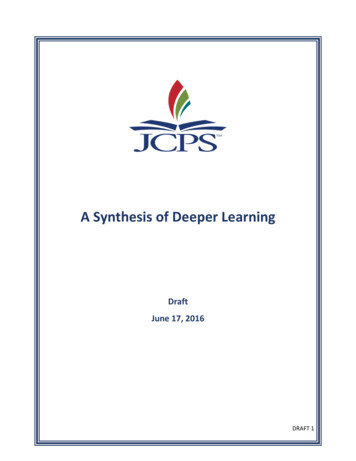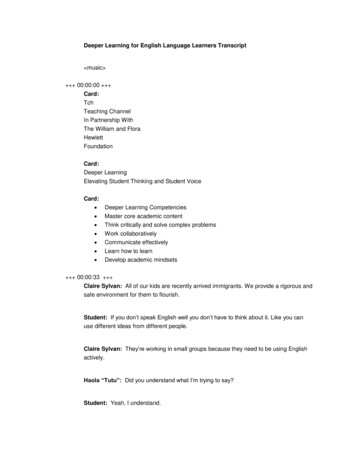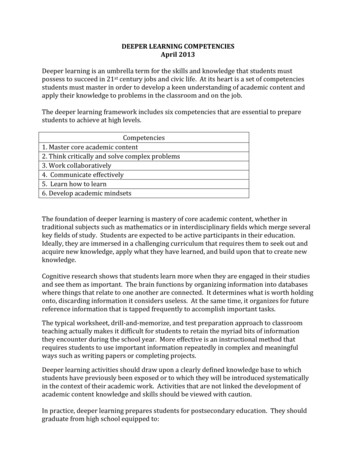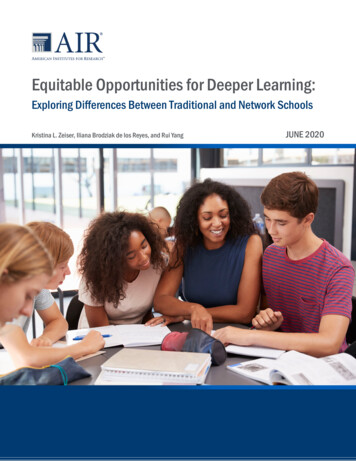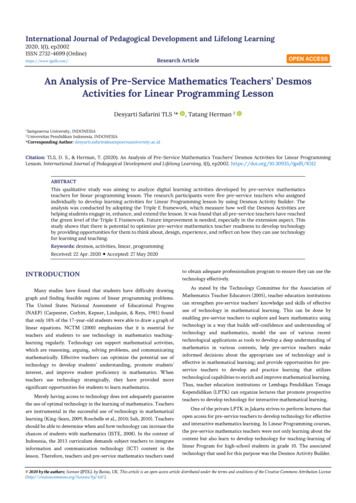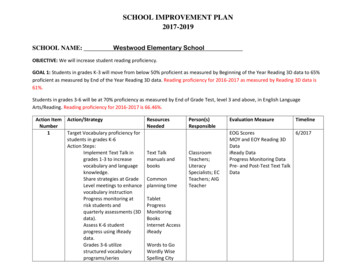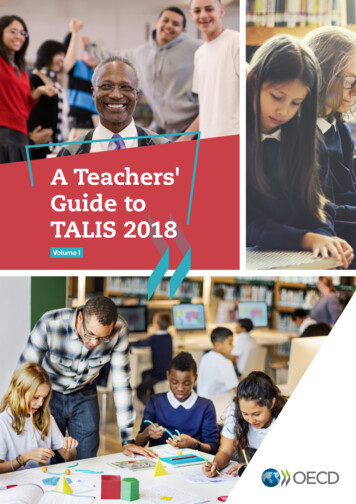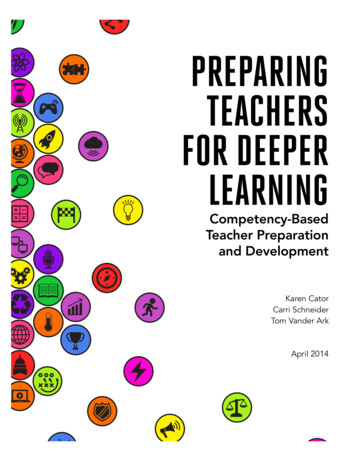
Transcription
PREPARINGTEACHERSFOR DEEPERLEARNINGCompetency-BasedTeacher Preparationand DevelopmentKaren CatorCarri SchneiderTom Vander ArkApril 2014
JOIN THE CONVERSATIONWebsites:Digital PromiseGetting ting learning
ContentsExecutive Summary. iIntroduction . 01The Shift to Personalized, Deeper Learning .01The Current State of Teacher Preparation .03The Current State of Professional Development .04The Current State of Accreditation.05A New Approach . 06Opportunities in Adult Learning . 07Lessons from Outside of Education.07Higher Education Innovators .09K-12 Innovators .11Competency-Based Teacher Preparation & Development . 16The Case for Competency.16Elements of A Competency-Based System .16Micro-Credentialing New Skills .17Moving Toward A Competency-Based System . 23Conclusion . 26Appendix A: Personalization v Differentiation v Individualization . 28Author Bios . 30Disclosures . 31Acknowledgements . 31Endnotes . 31
Executive SummarySchools and districts across the country are redefining the goals of K-12education and reimagining the very nature of teaching and learning, spurredby the implementation of college- and career-ready standards and the promiseof a new generation of online assessments. This collective “re-imagination” isrepresented by a range of evidence—from the individual teacher who discovers anew app that will make learning more engaging and meaningful for her studentsto the formal acknowledgment by the U.S. Department of Education’s NationalEducation Technology Plan’s renewed focus on the promise of personalizedlearning.“Preparing Teachers for Deeper Learning” explores the key questions:If, then, the goals of American education are beingredefined, and the opportunities are expanded with theadvent of technology, the Internet and digital content,how must the role of the educator evolve? And, howmust teacher preparation and ongoing professionaldevelopment evolve to fully enable teacher success inthis new environment?Through an exploration of these central questions, the authors assert:If we truly are to harness the power that technologybrings and seize the moment wrought by new collegeand career-ready standards supported by alignedassessments, we must reexamine the processes andmethods used to prepare teachers, accredit institutionsdoing the preparing, and support continuousdevelopment of teacher competency throughout theirprofessional careers.i
As calls for improving achievement andincreasing personalization of student learningecho across the national discourse, new adultlearning models are creating the potential forpersonalized preparation and developmentpathways for teachers. As student roles changein a personalized learning environment, teacherpreparation and professional learning shouldevolve accordingly in order to offer teachercontrol over time, place, path and/or pace;balanced goals; meaningful integration andcompetency-based progression.promote Deeper Learning competencies requireunique and varied teacher knowledge and skillsthat are often underdeveloped in traditionalteacher preparation.1Just as K-12 blended learning models offerstudents opportunities to learn in both in-personand online environments, blended teacherpreparation and development could combineonline learning with onsite experiences. Newpathways could be part of a formal degreeprogram or an alternative program, specific to agroup of schools or particular models.The paper begins with an introduction thatsituates the changing roles of teachers inside thebroader shifts to personalized, blended, DeeperLearning for students. After summarizing thecurrent state of teacher preparation, professionaldevelopment and accreditation, the authorsdescribe a new approach to high-quality teacherpreparation and ongoing professional learningopportunities that would offer:In the same way that student assessment isevolving to prioritize demonstrations of masteryover basic proficiency, competency-based teacherdevelopment would enable pre-service andpracticing teachers to demonstrate knowledgeand skills at regular intervals.Micro-credentialing, or badging, is a competencyrecognition system aligned with a series ofgates or milestones recognized by a community.Recent research and development efforts havefocused on the use of digital badges or tokensto signify accomplishment and to measure andreward competency-based outcomes. A seriesof micro-credentials could be used to mark initialpreparation as well as recognize and rewardongoing development and leadership in myriadaspects of the education profession.These competency-based pathways canachieve Deeper Learning learner outcomes,promoting active inquiry, critical thinking andcollaborative problem solving, as well as contentmastery. As a recent report illustrates, thereare different approaches to promoting DeeperLearning and college- and career-readiness;school models and instructional strategies thatThis paper outlines the attributes of nextgeneration teacher preparation and makesrecommendations to support the developmentof teacher preparation and development systemsthat will equip teachers to thrive in learningenvironments that develop Deeper Learningcompetencies.some element of teacher control over time,place, path and/or pace;balance between teacher-defined goals, goalsas defined by administration through teacherevaluation efforts, and school and districteducational goals;job-embedded and meaningful integrationinto classroom practice; andcompetency-based progression.Drawing on examples from outside of thefield of education as well as innovators inhigher education and K-12, the next sectionbuilds the case for competency-based teachereducation. This section defines the elementsof a competency-based system and describesmicro-credentialing in the context of teacherdevelopment.The authors conclude with recommendationsthat will move the field toward a competencybased system and a call to action regarding theimportance of better aligning teacher preparationand development with student Deeper Learninggoals.ii
IntroductionThe Shift to Personalized, Deeper Learning“Personalizedlearning meansinstruction ispaced to learningneeds, tailoredto learningpreferences, andsupported by thespecific interestsof differentlearners.”National EducationTechnology Plan:Learning Powered byTechnologyAcross the country, schools and districts are seizing the opportunity to reimaginethe very nature of teaching and learning, spurred by the implementation ofcollege- and career-ready standards and the promise of a new generation ofonline assessments.This trend is playing out in classrooms across the country and in the nationaleducation policy discourse—from individual teacher experimentation withnew ways to support learning to the U.S. Department of Education’s NationalEducation Technology Plan’s focus on personalized learning.Although time-consuming, individualized and personalized instruction hasbeen used by good teachers for decades to better address each student’sneeds. Now, with the ubiquity of more powerful and affordable devices and anincreasingly vast set of online and digital resources, it is possible to customizelearning at scale.The opportunity set afforded by higher standards and more comprehensivestudent assessments has led to calls from organizations like the William andFlora Hewlett Foundation to support the new goals of American education,specifically those goals that call for Deeper Learning. The Hewlett FoundationBeyond Differentiation and Individualized Instruction.Barbara Bray and Kathleen McClaskey’s work onPersonalize Learning breaks down the differencesbetween personalization, differentiation andindividualization—noting that only personalized learningshifts the focus from teachers to learners (see AppendixA).2 In an individualized environment, the teacher adaptsinstruction to accommodate the learning needs of theindividual. In a differentiated learning environment, theteacher designs instruction based on the learning needsof different groups of learners. In a personalized learningenvironment, learners take responsibility and haveownership of their learning.01
explains, “Deeper Learning is an umbrella termfor the skills and knowledge that students mustpossess to succeed in 21st century jobs andcivic life. At its heart is a set of competenciesstudents must master in order to develop a keenunderstanding of academic content and applytheir knowledge to problems in the classroom andon the job.”3 The Hewlett Foundation’s DeeperLearning framework identifies six interconnectedcompetencies that are essential components of21st century college- and career-readiness:4Master core academic contentThink critically and solve complex problemsWork collaborativelyCommunicate effectivelyLearn how to learnDevelop academic mindsetsIf, then, the goals of American education arebeing redefined, and the opportunities areexpanded with the advent of technology, theInternet and digital content, how must therole of the educator evolve? And, how mustteacher preparation and ongoing professionaldevelopment evolve to fully enable teachersuccess in this new environment?The National Education Association’s (NEA) PolicyStatement on Digital Learning speaks to thesequestions:“NEA believes that the increasing use oftechnology in the classroom will transformthe role of educators allowing the educationalprocess to become ever more studentcentered. This latest transformation is notnovel, but part of the continuing evolutionof our education system. Educators, asprofessionals working in the best interestsof their students, will continue to adjust andadapt their instructional practice and use ofdigital technology/tools to meet the needsand enhance the learning of their students.”The NEA’s sentiment is echoed in a recent paperfrom Digital Learning Now, Getting Smart andPublic Impact. Improving Conditions & Careers:How Blended Learning Can Improve the TeachingProfession explains how the shift to online andThe Clayton Christensen Institute definesblended learning as a system of education inwhich students learn:at least in part through online learning, withsome element of student control over time,place, path and/or pace;at least in part in a supervised “brick-andmortar” location away from home;using modalities along each student’slearning path within a course or subject thatare connected to provide an integratedlearning experience.7blended learning can benefit both teachers andstudents since “each group benefits from theability to personalize learning, increase studentengagement, access better student data,customize content, support diverse learningmodalities and vary delivery methods.”5Teaching is a field in which job satisfaction is atits lowest rate in decades, although new inspiredand “powered-up” learning environmentsmay reverse this trend. In “Improving TeacherConditions and Careers the authors explain, “Theshift to personalized, blended learning will yieldextended time with students, more team-teachingand collaboration, new options to teach at home,a greater focus on deeper learning, individualizedprofessional development plans, better studentdata to inform instruction, and more earningpower.”6If we truly are to harness the power thattechnology brings and seize the moment wroughtby new college- and career-ready standardssupported by aligned assessments, we mustreexamine the processes and methods used toprepare teachers, accredit institutions doing thepreparing, and support continuous developmentof teacher competency throughout their careers.02
The Current State of TeacherPreparationThere was a big but generally unrecognizedpreparation problem 10 years ago when ArtLevine began researching his groundbreakingreport, Educating School Teachers.8 The problemhas grown exponentially worse with advancesin technology, the development of new schoolmodels, diversifying student populations and theshift to new college- and career-ready standardsand the next generation of assessments.Even a modest investment of time in tracking thecurrent trends in education will yield evidencethat student roles in the classroom are evolving.Armed with new tools and empowered bynew standards, students are gaining access tonew, increasingly online and blended learningopportunities that have the potential toenable the development of Deeper Learningcompetencies. But in order to enable theseenvironments fully, prospective teachers must alsolearn within this new context. As they prepare toenter the classroom, they also can benefit fromthe same type of personalized, blended learningopportunities. On the whole, however, teacherpreparation in this country currently remainsconstrained, inflexible and disconnected fromshifts in the classroom as well as from emergingopportunities to support learning.As Thomas Arnett of the Clayton ChristensenInstitute explains, “Emerging personalizedlearning models are transforming the role ofthe teacher. Teachers in these models findthemselves acting more as coach and mentor thanas deliverers of direct instruction. As such, theskills they need to successfully fulfill their jobs areshifting, but many of the programs that train themremain static.”9Many would argue that generally speaking,teachers are not graduating from colleges ofeducation with the skills and competenciesneeded to be successful in the outdated factorymodel of education that still plagues manyclassrooms, let alone prepared to thrive in thenew teacher roles necessitated by shifts tostudent-centered, personalized Deeper Learning.Many teachers and students do not yet havethe knowledge and skills to apply technologyto learning in completely new and meaningfulways.10 Teachers who work inside schools thatpersonalize and inspire learning challengestudents with real world problems, and aresupported with the technology tools for creating,publishing, researching, thinking and composingmust be adept at orchestrating learning.11 As newmodels of teaching and learning emerge, suchas those profiled in Deeper Learning For EveryStudent Every Day, the notion of credentialingteachers based solely on grade bands andcontent areas will become increasingly obsolete.With the growth of purpose-built schools andnetworks, we believe teachers will be betterserved by a series of credentials that measureproficiency of the unique and discrete skillsnecessary to be successful in each model usingspecific toolsets. This certainly necessitates a newapproach to preparing and developing teachers,specifically by engaging them as learners in justthis type of learning environment.Recognizing both the shift to personalized,blended learning and the problems with currentteacher preparation, the work of the Council ofChief State School Officers (CCSSO) throughthe Interstate Teacher Assessment and SupportConsortium (inTASC) created the Model CoreTeaching Standards and Learning Progressions forTeachers 1.0. This “common core for teachers”describes “the principles and foundations ofteaching practice that cut across all subject areasand grade levels and that all teachers share.”12The standards were designed specifically to“articulate what effective teaching and learninglooks like in a transformed public educationsystem—one that empowers every learner to takeownership of their learning, that emphasizes thelearning of content and application of knowledgeand skill to real world problems, that values thedifferences each learner brings to the learningexperience, and that leverages rapidly changinglearning environments by recognizing thepossibilities they bring to maximize learning andengage learners.”1303
The Current State ofProfessional DevelopmentWith the emerging implementation of dynamiceducational initiatives, it is essential thatteachers have access to high-quality, ongoingprofessional learning as their role and methodschange. Professional development (PD) has filledthis role, but the system of PD as it currentlyexists is unsatisfactory to many,15 includingHarvard University professor Heather C. Hill,who writes, “The professional development‘system’ for teachers is, by all accounts,broken.”16 Opportunities for PD tend to be“short-term, episodic, and disconnected” fromteachers’ in-class practice;17 they are often heavyon front-loaded content but fail to supportteachers in the implementation stage and focuson generic techniques of little use to mostteachers. A landmark study by the NationalStaff Development Council found that over 90percent of teachers reported having participatedin professional development in the past yearhowever, only 59 percent of teachers foundcontent-related PD useful, and fewer than halffound PD useful in other areas such as technologyuse, reading instruction, special education andclassroom management.18The Center for Public Education reports thateffective professional development must allowtime for teachers to learn a new strategy andgrapple with the implementation problem byaddressing the specific challenges of changingclassroom practice.19 A recent report reviewedstudies on PD and found that teachers whoreceive at least 14 hours of professionaldevelopment demonstrated “a positive andsignificant effect on student achievementfrom professional development” and that“teachers who receive substantial professionaldevelopment—an average of 49 hours in the ninestudies [reviewed by this report]—can boost theirstudents’ achievement by about 21 percentilepoints.”20Progress in Teacher Prep. To date, seven stateshave adopted policies for using edTPA—apartnership between Stanford University’sStanford Center for Assessment, Learning andEquity (SCALE) and the American Associationof Colleges for Teacher Education (AACTE)that creates a multiple-measure assessmentsystem aligned to state and national standardsincluding Common Core State Standards (CCSS)and the Interstate Teachers Assessment andSupport Consortium (InTASC).14 With regardto universities, pioneers include two Idahouniversities with Albertson Foundation grantsto pursue blended and competency-basedapproaches to preparation. The AlbertsonFoundation grants will establish Doceõ Centersfor Innovation Learning at University of Idahoand Northwest Nazarene University. Otherexamples include New York City’s innovative newRelay Graduate School of Education that intendsto be an early adopter of micro-credentialing inteacher training by piloting badges in
environments that develop Deeper Learning competencies. The paper begins with an introduction that situates the changing roles of teachers inside the broader shifts to personalized, blended, Deeper Learning for students. After summarizi
